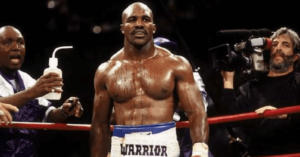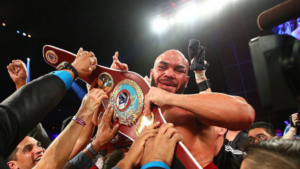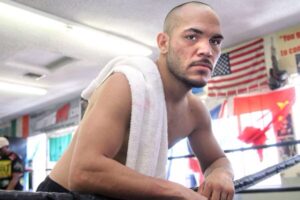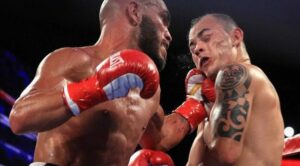Recently, former WBC female world champion, Mia St. John, set the boxing Twittersphere on fire with tweets defending Saul ‘Canelo’ Alvarez against the heated criticism faced by the Mexican star after he tested positive for the banned substance clenbuterol earlier this year.
St. John went on to say that ‘everyone does it’ in reference to the taking of performance-enhancing drugs (PEDs) in boxing and then, in an interview with the LA Times, lay bare her own PED-use while a professional fighter.

Her tweets and subsequent confession sparked widespread indignation and condemnation from the boxing world, ranging from fighters such as Tony Bellew, Claressa Shields and Sergio Mora up to boxing journalist Steve Bunce, all of whom felt that her comments and actions had tarnished the sport and its clean fighters.
St. John’s PED-use during her career is indefensible. Her initial comments on Twitter were ill-thought out and clumsily worded by her own admission. Yet there was a grain of truth in her allusion to a double-standard that exists in boxing, whereby one rule is applied to certain people and another to others.
The aforementioned Bellew has been an outspoken critic of PED-use in boxing, insisting that any boxer who tests positive for PEDs should be banned from the sport outright. Yet he has also professed his admiration for Evander Holyfield, who he once lauded as ‘the greatest cruiserweight of all time’. Holyfield has been dogged for years over allegations of steroid-use which remain unproven to this day but are utterly credible on a reading of the facts.

The list of high-profile boxers who have fallen foul of drugs tests in recent years is however beyond doubt. Canelo finds himself in exalted company alongside names such as Roy Jones Jr, James Toney and Erik Morales, all of whom are future or current boxing hall-of-famers.
One man who won’t be going to the ‘Hall of Fame’ but still managed to taste championship glory at the highest level of boxing is Canelo’s countryman, former WBO lightweight titleholder Ray Beltran. On Saturday night, he lost his belt in his first title defence against Puerto Rico’s Jose Pedraza; a clear loss on points punctuated by Beltran taking a trip to the canvas in the penultimate session and barely surviving being stopped in the final round. It likely signifies the end of the road for Beltran, who has experienced a roller-coaster career that began back in 1999 shortly after he crossed the border from Mexico to the United States.

A long-serving sparring partner for Manny Pacquiao, Beltran seemed destined to ply his trade as the ‘opponent’ after experiencing a series of early career reversals; a stepping stone for up-and-coming contenders. He then, however, put together a string of decent wins to secure a 2013 title shot against then-WBO lightweight World champion Ricky Burns in the latter’s native Scotland. Beltran put on the performance of his life, knocking down Burns in the eighth round, breaking his jaw and outfighting him throughout, only to be robbed by a ridiculous split-decision draw.
Two more failed attempts at a World title followed – one in which Beltran was outclassed by rising pound-for-pound star Terence Crawford, the other against Takahiro Ao in which he failed to make weight and was ineligible to win the belt despite demolishing his Japanese foe in two rounds – before the fourth time proved lucky in a bloody, action-packed battle against fellow veteran Paulus Moses for the vacant WBO belt.

Beltran had finally achieved a lifetime dream of becoming a boxing World champion, albeit facing a faded fighter who had been irrelevant at the weight for years and had no real business being in a World title fight. That fact was largely lost in the bonhomie of the moment; seeing a genial, hardworking and hard-done-by immigrant father of three reach the pinnacle of the most punishing of professions against all the odds.
And if there wasn’t already enough feel-good-factor attached to the story, circumstances beyond the ring contrived to magnify it manifold. Just before the fight with Moses, Beltran learned that his petition for a green card, entitling him to permanent residence in the United States, had been granted to him as an ‘Alien of Extraordinary Ability’ based upon his sporting achievements. Winning the World title effectively sealed the deal and ensured his future in his adopted country.
It Is a story to soften even the most hardened of hearts in a sport as brutal and unforgiving as boxing and the accolades came pouring in from fighters, fans and boxing writers alike. But there is a black mark staining its pages: for Ray Beltran was also a certified PED-user.

Following his botched title bout with Ao, he tested positive for the anabolic steroid stanozolol. The result of the bout was changed to a no-contest and Beltran was fined and suspended by the Nevada State Athletic Commission as well as having an upcoming fight against Humberto Soto cancelled. Ao, who took a vicious beating on the night he faced Beltran, has not fought since.
Beltran’s positive test casts a dark shadow not just over Ao’s fate but the nature and outcome of his next three fights, all brutal knockout victories against Ivan Najera, Mason Menard and Jonathan Maicelo. Prior to Najera, Beltran last official win by knockout came in 2011 against overmatched Darien Ford. Following Maicelo and before facing Moses for the world title, the knockout artist re-born fought former super featherweight title challenger, Bryan Vazquez, and was significantly less sizzling.
The undersized Vazquez, who had been battered mercifully and stopped by Takashi Uchiyama at 130lbs, took everything which Beltran threw at him that night and even managed to badly hurt the favourite in the final round, losing a close majority decision. Should we take this for a purely incidental sequence of events? The reader can be the judge of that.

Beltran has acknowledged his mistake and expressed his regret for it, claiming in mitigation that he took a substance despite knowing it was illegal in his desperation to make weight for the Ao fight. As it turns out, he still failed to make weight. And, as any lawyer worth his salt will concede, remorse and mitigating circumstances are no defence. Neither should they be, particularly in a sport like boxing in which the participants put their health and lives on the line every time they compete.
It is open to question whether Canelo intentionally took PEDs but there is no question that Beltran did so. Yet, the contrast in the reaction from the boxing World to their two cases, particularly from within the ‘hardcore’ boxing subculture, could not be greater.

One could put it down to Canelo’s status as one of the ‘faces’ of the sport today and a polarising one at that; loved by many but reviled by others. With a truckload of detractors already on his tail followed his fortunate split-decision draw against Gennady Golovkin in their first meeting last year, his subsequent positive drugs test was bound to add fuel to the fire for them.
In terms of recognition, Beltran is nowhere near Canelo’s public profile and boasts an underdog’s tale which is easy for boxing aficionados to root for. It is hard not to feel good for a genuinely likeable man who has battled adversity in his life and career and seems to have settled on top. It does not however justify the double standard. Put emotions firmly to one side, there can be no grey areas here.

So spare a thought for Takahiro Ao (remember him?) and other boxers who have taken beatings at the hands of juiced-up opponents and who may never truly recover. And if we are to condemn, let us do so with even-handedness and treat like cases for like, regardless of personality, record, earnings, star power or background.
To paraphrase George Orwell, ‘all boxers are created equal, but some are more equal than others.’
Article by: Paul Lam
Follow Paul on Twitter at: @PaulTheWallLam